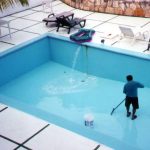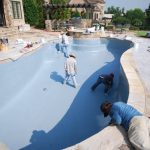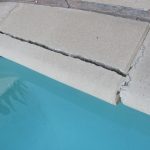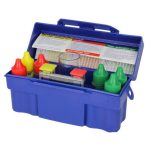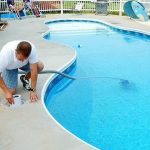There’s nothing more frustrating than walking outside to see your pool has turned a murky green color. It doesn’t just look bad—it can also be unsafe to swim in. A green pool usually means algae are taking over, and it needs your immediate attention. But don’t worry, cleaning it doesn’t have to be overwhelming. In this guide, we’ll show you exactly how to turn your green pool back into crystal-clear water. We’ll also look at what it costs, whether to do it yourself or hire a pro, and how to keep it from happening again.
Why Your Pool Turned Green and How to Fix It
A pool turns green because algae, tiny plants that grow in water, are thriving. Algae love warm water, low chlorine levels, and poor water circulation. If you skip cleaning or don’t add enough chemicals, algae will start growing and spread fast. There are three types of algae that can affect your pool: green (the most common), mustard, and black algae.
When your pool starts to turn green, it’s important to act quickly. The longer you wait, the harder it will be to clean. The first step is understanding why this happened. You could have low chlorine levels, poor filtration, or a broken pool pump that’s not circulating the water properly.
To fix it, you’ll need to clean the pool, balance the chemicals, and make sure the pump and filter are working well. Let’s dive into the steps.
Tools You Need to Clean a Green Pool
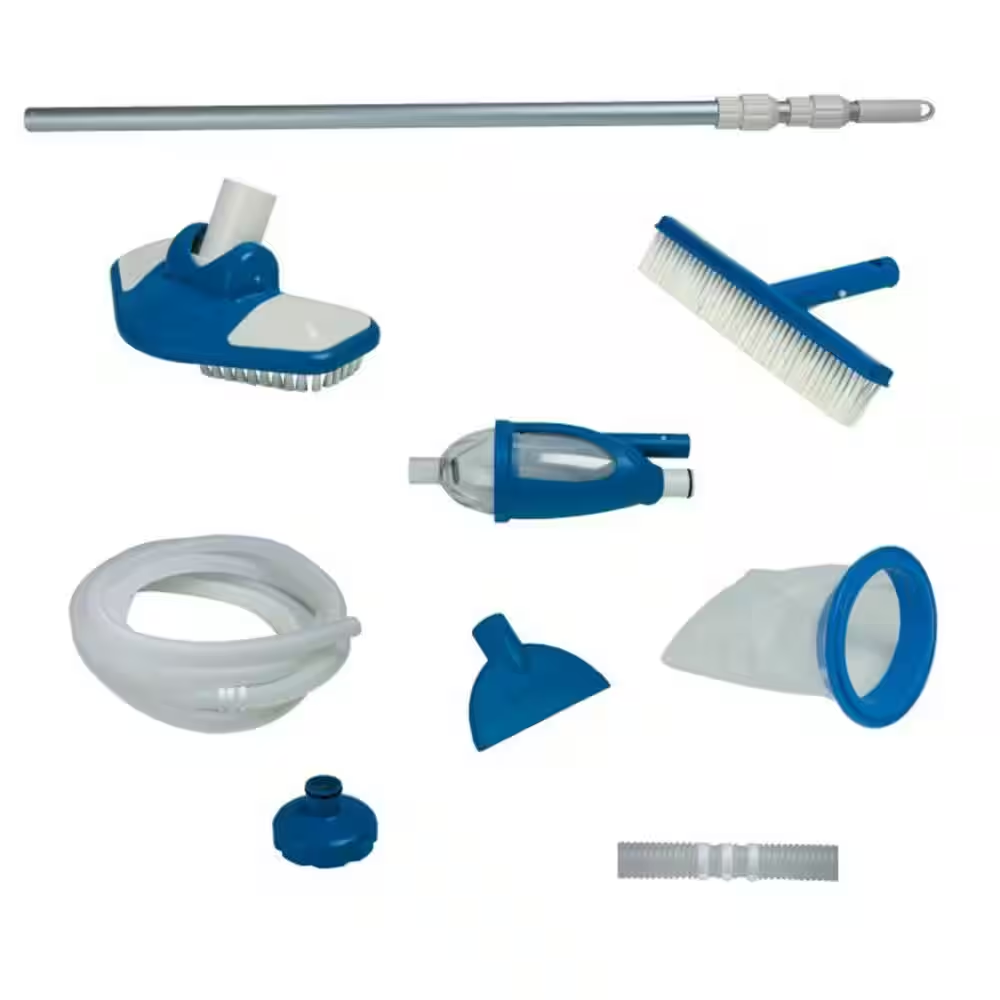
Cleaning a green pool is easier when you have the right tools. Here’s a list of what you’ll need:
- Pool brush: Use this to scrub the walls and floor pool tile cleaning to loosen the algae.
- Pool vacuum: Either a manual or automatic vacuum will help remove algae and dirt from the bottom.
- Leaf skimmer: Use this to scoop out debris floating on the surface.
- Water test kit: You need this to check your chlorine and pH levels before and after cleaning.
- Pool pump and filter: These should be working well to circulate and clean your water.
- Chlorine shock: This is a strong dose of chlorine that kills algae quickly.
These tools aren’t too expensive. You can get a good pool brush for $15, a leaf skimmer for $10, and a vacuum starting at $30. A good water test kit costs around $20. Most of these items will last you a long time if you take care of them.
How Much Does It Cost to Clean a Green Pool?
Now, let’s talk about the cost. Whether you clean your pool yourself or hire a professional, there are costs involved.
- DIY Cleaning: If you clean the pool yourself, expect to spend around $50 to $150 on chemicals like chlorine shock, algaecide, and pH balancers. If you don’t have the tools like a vacuum or brush, you may need to buy those, which can add another $50 to $200 depending on what you need.
- Professional Cleaning: If you’d rather hire someone, expect to pay $200 to $500 for a one-time cleaning. The price depends on how bad the algae problem is and how big your pool is. In some severe cases, The pool cleaner professional can cost up to $600 if the algae is out of control and needs multiple treatments.
For most people, DIY is the cheaper option, but hiring a professional can save you time and stress, especially if the algae problem is severe.
DIY Green Pool Cleaning vs. Hiring a Professional
So, should you clean your pool yourself or hire a professional? Below is a detailed comparison of both options to help you decide which works best for you.
| Feature | DIY Cleaning | Professional Cleaning |
|---|---|---|
| Cost | $50 – $150 (initial for chemicals); $30 – $60 monthly | $200 – $500 (one-time service); $100 – $150 monthly |
| Time Commitment | High—several hours to a few days, depending on severity | Low—usually completed in a few hours |
| Expertise Required | Minimal—basic knowledge of chemicals and equipment needed | High—trained professionals with expertise in pool care |
| Control Over Process | Full control—decide when and how to clean | Limited control—must rely on the cleaner’s methods |
| Physical Labor | High—requires scrubbing, vacuuming, and heavy lifting | Low—professionals do all the hard work |
| Results Consistency | Varies—may require multiple attempts for best results | Reliable—trained to achieve consistent, professional results |
| Equipment Quality | Personal—may use standard home equipment | Professional—uses advanced tools and chemicals |
| Learning Opportunity | Yes—gain experience and knowledge about pool maintenance | No—less hands-on experience for the homeowner |
| Emergency Availability | Immediate—can start cleaning whenever you’re ready | Limited—may need to schedule an appointment |
For most people, DIY is the more affordable option if they have the time and confidence to handle the chemicals and cleaning. However, if you’re dealing with a severe algae problem or just don’t have the time, hiring a professional like Pool Responders in Gatesville, TX can save you the stress and ensure your pool is cleaned thoroughly.
How to Clean a Green Pool the Right Way
A green pool means algae has taken over, but don’t worry—it can be fixed. To clean a green pool, start by testing and balancing the water’s pH level. Then, shock the pool with a strong chlorine dose to kill the algae. Run the filter nonstop for at least 24–48 hours and brush the walls and floor to remove buildup. After that, vacuum out the dead algae and keep filtering until the water clears. Regular pool care and the right chemicals will help prevent your pool from turning green again.
How Long Does It Take to Clean a Green Pool?

The time it takes to clean a green pool depends on how bad the algae problem is. If your pool is only slightly green, it could take as little as 24 hours to clean. However, if the water is dark green and cloudy, it might take 2 to 3 days to fully clear up.
When you add chlorine shock to the pool, you should start to see results within a day. The water will begin to clear up as the algae die off. After that, it’s important to run the pool pump continuously to filter out the dead algae and clean the water.
Chlorine Shocking Your Green Pool: How It Works
Shocking your pool means adding a large amount of chlorine to kill the algae. Here’s how you do it:
- Test the water and adjust the pH if needed (it should be between 7.2 and 7.6 for the shock to work best).
- Add the chlorine shock to the pool. The amount depends on the size of your pool and how severe the algae is. For a medium-sized pool, you may need about 2-4 lbs of shock.
- Let the pool pump run continuously to help circulate the chlorine and kill the algae.
- After about 24 hours, you should see the water clearing up. You might need to brush and vacuum the pool to remove the dead algae.
Chlorine shock usually costs $30 to $50 for a 5-lb bag, and you’ll need 2-4 lbs depending on the size of your pool and algae level.
The Cost of Pool Cleaning Services
If you’re thinking of hiring a professional, here’s what you can expect to pay:
- One-Time Cleaning: $200 to $500 depending on the algae growth and pool size.
- Severe Algae Cases: Up to $600 if your pool has a heavy infestation.
- Routine Maintenance: For ongoing cleaning services, expect to pay around $100 to $150 per month.
In Gatesville, TX, you can find reliable local services like Pool Responders that offer fast and affordable cleaning options.
Preventing Your Pool from Turning Green Again

Once you’ve cleaned your pool, the last thing you want is for it to turn green again. Here are some tips to prevent algae from coming back:
- Test the water regularly to make sure the chlorine and pH levels are balanced.
- Run the pool pump daily to keep water circulating. Algae love still water.
- Brush the walls and vacuum the bottom of the pool every week to stop algae from attaching to the surfaces.
- Use a pool cover when the pool isn’t in use. This keeps out debris and blocks sunlight, which algae need to grow.
- Add algaecide regularly to prevent algae from taking hold.
Frequently Asked Questions (FAQs)
Q: How do I know if my pool is turning green?
A: If the water looks cloudy, green, or smells bad, it’s likely turning green. You might also notice slippery surfaces or green spots on the walls and floor.
Q: How long does it take to see results after shocking the pool?
A: You should see some improvement within 24 hours. However, it might take a few days for the water to completely clear up.
Q: Can I swim in my pool while it’s turning green?
A: It’s not safe to swim in a green pool. The water can be unhealthy and may cause skin and eye irritation.
Q: How often should I clean my pool to prevent it from turning green?
A: It’s best to clean your pool weekly, but you should check the water chemistry and brush the surfaces at least every few days, especially during hot weather.
Q: Is it better to use chlorine or saltwater systems for algae prevention?
A: Both systems can be effective, but regular maintenance and testing are crucial. Chlorine systems


